10 Essential Steps to Mastering Dog Obedience Training: The Key to a Well-Mannered Dog
Have you ever thought about how to make your dog well-behaved and obedient? The answer is dog obedience training. But, where do you start? This guide will show you the 10 essential steps to make your dog better through positive training.
Imagine your dog sitting calmly by your side, following commands, and handling crowds easily. This is what dog obedience training can do. It makes your dog safer and happier1. It also strengthens your bond with your dog1.
Key Takeaways
- Mastering the top 10 essential dog commands, including Sit, Stay, Come, and Heel1
- Understanding the profound impact of obedience training on dog behavior and safety1
- Utilizing positive reinforcement techniques to foster a stronger bond with your canine companion1
- Developing a detailed training plan for your dog’s needs and personality
- Overcoming common behavioral issues with systematic training and socialization
Understanding the Foundations of Canine Behavior
As a dog owner, knowing the basics of canine behavior is key for good obedience training. Dogs, like us, live in a pack and need a leader. By understanding this and reading their body language, we can communicate better and bond stronger with our dogs2.
Natural Pack Mentality and Leadership
Dogs are social animals, shaped by their pack history. In a pack, there’s a leader. As the owner, you must be that leader, guiding your dog in training and daily life. Being the pack leader helps you communicate better and get a well-behaved dog2.
Reading and Interpreting Dog Body Language
It’s important to watch and understand your dog’s body language during training. Signs like tail wagging and eye contact tell you how they feel and what they want. Learning these signals helps you predict and respond to their actions, making training more successful2.
Understanding Breed-Specific Traits
Different breeds have unique traits and behaviors that need special training. For example, herding breeds do well with movement commands, while sporting breeds are great at retrieving. Knowing these traits helps you tailor your training to your dog’s strengths, making sessions more effective and fun2.
By understanding these basics, you’ll get better at obedience training and have a well-behaved dog. Remember, every dog is different, and a custom approach is the best way to succeed3.

“Positive reinforcement techniques, rooted in an understanding of dog psychology, are the foundation of effective obedience training. By focusing on building a strong bond and rewarding desirable behaviors, we can create a confident, well-behaved canine companion.”
Getting Started with Dog Obedience Training
Starting dog training can be fun and rewarding. It’s all about teaching basic commands like sit, stay, and come4. Begin training when your puppy is 6 to 7 weeks old4.
Training should be short and frequent. Aim for 10 to 15 minutes, two to three times a day4.
Positive reinforcement is key. Give treats and praise when your dog does what you want4. This method helps your dog learn and strengthens your bond5.
Being consistent is important. Use the same commands and rewards everywhere5.
If you’re not sure where to start, get help from a certified dog trainer4. They can create a training plan that fits your dog’s needs5. They can also help with problems like jumping or barking5.
Training takes patience and a positive attitude5. Stick to these basics to build a strong bond with your dog5.
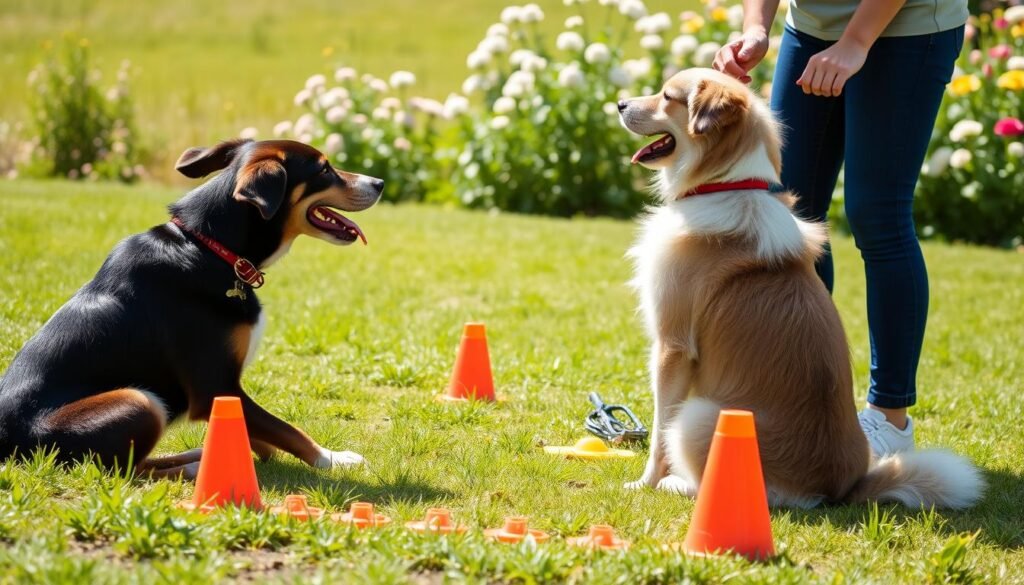
“Consistency is the key to effective dog training. By reinforcing the same commands and behaviors, your dog will learn faster and retain the lessons better.”
Essential Training Tools and Equipment
Getting the right tools and accessories is key for dog obedience training. You need the right training collar and leash. Also, picking the perfect reward system is important. The right equipment can greatly help your training success.
Selecting the Right Training Collar and Leash
The right collar and leash depend on your dog’s size, temperament, and training goals. A 6-foot leash is best for control and movement during training6. Stay away from harsh training tools like prong collars and e-collars. They can hurt your dog physically and emotionally. Choose humane, positive training methods instead.
Treat Selection and Reward Systems
Treats are great motivators and rewards in dog training. Pick high-value, small treats that your dog loves6. Treat pouches are handy for keeping rewards ready during training7. Using a clicker or marker words can also help time rewards well.
Training Aids and Accessories
Many accessories can help with your dog’s training. Crates are safe and useful for housetraining and behavior6. Chew toys and treat-dispensing toys keep your dog busy and prevent bad behavior7. Calming aids like Thundershirts can help dogs with anxiety.
When choosing trainers, look for certified ones. Check for certifications from the CPDT, KPA, IAABC, or ABS6. Online reviews on Yelp and Google can also help find good trainers near you.
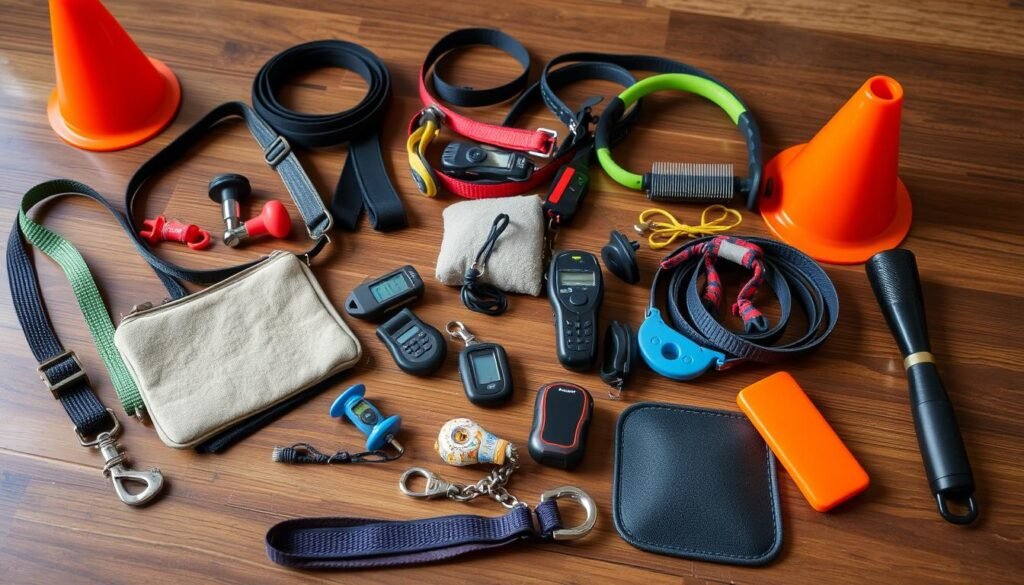
Investing in the right tools and getting help from certified trainers is key. It helps your dog succeed and strengthens your bond through obedience training.
Mastering Basic Commands: Sit, Stay, and Come
Watching your dog learn basic commands like “sit,” “stay,” and “come” is incredibly rewarding. These skills are key for a well-behaved pet and can save lives in emergencies8. Over 90% of dog owners see these commands as essential for a well-mannered dog. With regular training, your dog will become more confident and trustworthy8.
The “sit” command is a foundational skill. It helps dogs stay calm in many situations, like when meeting guests or waiting for food8. Training consistently makes your dog more confident and well-behaved, handling social situations and emergencies better8.
The “stay” command is vital for a dog’s self-control. It can save them from dangerous situations, like running into the street8. A well-trained dog is less likely to get into trouble and is more welcome in public and around guests. This makes outings and gatherings more enjoyable8.
The “come” or “recall” command is essential for your dog’s safety. When trained well, it ensures your dog returns to you, avoiding harm8. Training commands can also improve your dog’s physical health by encouraging movement and activity, which is important for high-energy breeds8.
Use clear verbal cues and hand signals when teaching these commands. Reward your dog immediately for correct responses9. Puppies learn quickly, so keep training sessions short, around five minutes, and do them several times a day for best results9. With patience and practice, your dog will master these essential skills, becoming a well-behaved, confident, and trustworthy companion8.
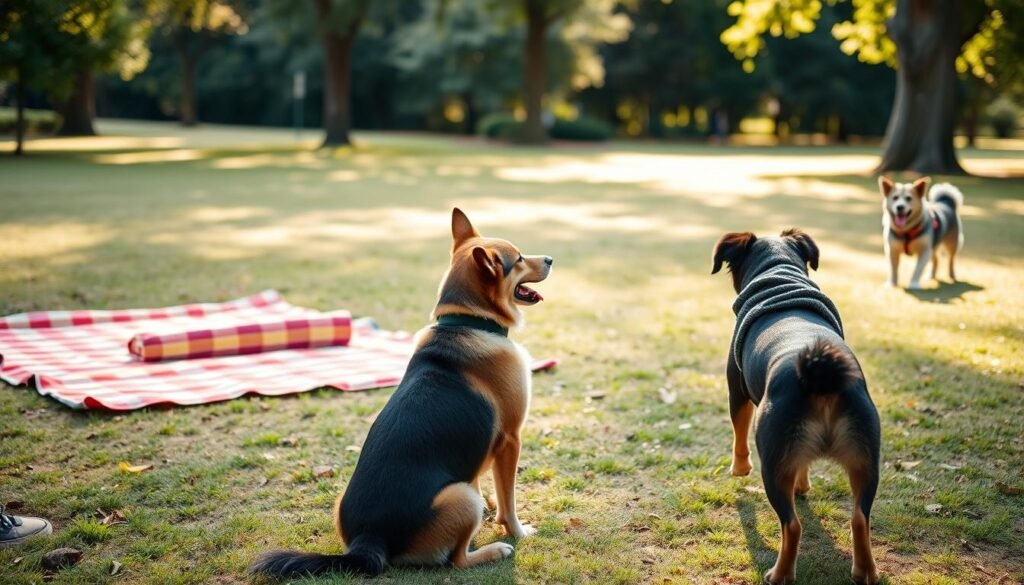
Mastering basic commands is just the beginning of your dog’s obedience training journey. By building a strong foundation, you set the stage for more advanced techniques and a deeper bond with your four-legged friend.
“Consistency is key when it comes to training your dog. With patience and positive reinforcement, you’ll be amazed at how quickly they can learn and follow even the most complex commands.” – Dog Training Expert, Jane Doe
Obedience training is a journey, not a destination. By adding these basic commands to your daily routine and gradually increasing the difficulty, you’ll have a well-trained, well-behaved dog. Remember to end training sessions positively to keep motivation high9.
- Consistently practice the “sit” command to help your dog remain calm in various situations8.
- Teach the “stay” command to develop your dog’s self-control and prevent them from running into dangerous situations8.
- Master the “come” or “recall” command to keep your dog safe and ensure they return to you when called8.
By mastering these basic commands, you’ll have a well-behaved companion and a dog better equipped for everyday challenges8. Regular practice and repetition are key to successful dog training. Short training sessions throughout the day keep your pup engaged and focused10.
| Command | Purpose | Training Tips |
|---|---|---|
| Sit | Calms dogs, useful for greeting guests and waiting for meals | Use clear verbal cue and hand signal, reward immediately for correct response9 |
| Stay | Develops self-control, prevents dogs from running into danger | Start with short durations, gradually increase difficulty, reward for compliance9 |
| Come (Recall) | Crucial for keeping dogs safe, can be life-saving in emergencies | Practice in various environments with distractions, use high-value treats10 |
Mastering these basic commands lays the foundation for a well-trained, well-behaved dog8. By using positive reinforcement, consistent timing, and gradual exposure to distractions, you’ll be well on your way to having a canine companion that is a joy to be around10.
Advanced Training Techniques and Positive Reinforcement
Teaching your dog more than just basic commands is key to a well-behaved pet. Advanced training builds on positive reinforcement11. It’s important to reward your dog right after they do what you want11. Using the same commands like “sit,” “stay,” and “come” helps avoid confusion11.
Clicker Training Methodology
Clicker training is a top-notch method. It uses a clicker to mark the exact moment your dog does what you want11. This makes training easier and more effective11.
Marker Words and Timing
Marker words like “yes” or “good” work like a clicker to give clear feedback11. Food treats are great for training because dogs love food11. Start with treats for new behaviors, then switch to rewards less often as they learn11.
Progressing Through Difficulty Levels
12 Advanced training boosts a dog’s confidence and focus12. It makes them reliable in tough situations, like off-leash12. Dog sports and activities like agility are easier with advanced training12.
12 Regular practice is key to keeping training effective12. Keeping your dog motivated and focused is a big challenge12. Fixing issues like fear or aggression is important before moving on12.
12 Tools like clickers and high-quality treats are essential for advanced training12. Advanced training includes distance commands and off-leash control12. It also includes agility training for obstacles and tunnels12.
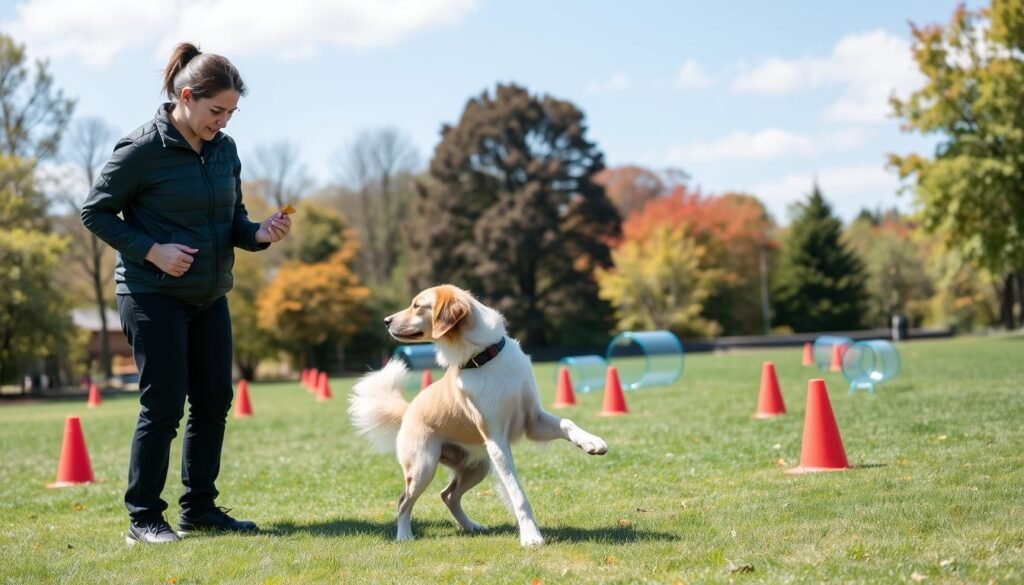
“Positive reinforcement is the foundation for building a strong bond and trust between a dog and their owner, making training an enjoyable experience for both.”
Leash Training and Proper Walking Etiquette
Teaching your dog to walk nicely on a leash is key for peaceful walks. The “Heel” command helps them stay by your side13. Use treats to reward them for walking calmly, avoiding pulling13. Practice in different places to make sure they learn everywhere14.
To stop leash pulling, stop moving when the leash tightens. Only go forward when it’s loose14. This method not only improves walking but also makes walks more fun14.
For dogs that pull, try front-hook harnesses or head halters13. Also, fix any behavioral problems, like barking at other dogs13. Enough exercise and mental games can solve these issues13.
Stick to positive training and practice often to master leash training14. With patience and effort, you’ll have stress-free walks and a closer bond with your dog15.

| Leash Training Technique | Benefit |
|---|---|
| Reward-based Training | Encourages loose leash walking and the “Heel” command |
| Specialized Equipment (Harnesses, Head Halters) | Helps manage dogs that tend to pull on the leash |
| Addressing Behavioral Challenges | Resolves issues like barking at other dogs during walks |
| Consistent Practice and Positive Reinforcement | Leads to well-mannered walking companions |
“Consistent practice and a commitment to positive reinforcement are the keys to mastering leash training and ensuring that your dog becomes a well-mannered walking companion.”
By following these steps, you can improve your dog’s walking manners. Leash training is vital for a well-behaved, confident dog15.
Addressing Common Behavioral Challenges
As a responsible dog owner, it’s key to tackle any behavioral issues with your dog16. Common problems include too much barking, chewing things they shouldn’t, and jumping on people16. These issues can come from boredom, not enough exercise, fear, bad training, wanting attention, or even health problems16.
Dealing with Jumping and Barking
Positive training is the best way to handle jumping and barking16. Teach your dog to be quiet with the “Quiet” command16. Also, teach them to sit calmly when they meet people16. Giving them the right chew toys can also stop destructive chewing16.
Managing Aggression Issues
Aggression in dogs can be hard to deal with17. It might come from fear, not being socialized enough, defending their territory, pain, or wanting to protect17. Using techniques like counterconditioning and desensitization can help with fear-based aggression17. If it’s serious, getting help from a certified trainer or behaviorist is a good idea16.
Solving House Training Problems
House soiling can be tough, but it can be fixed with a routine and positive rewards17. Make a schedule for when to take your dog out16. Praise and treat them when they go in the right place16. If it doesn’t get better, check for health problems17.
Fixing common dog behavior problems takes time, understanding, and consistent training16. Use positive training methods and get help when needed16. Early socialization, regular exercise, and keeping their mind busy are also important17.
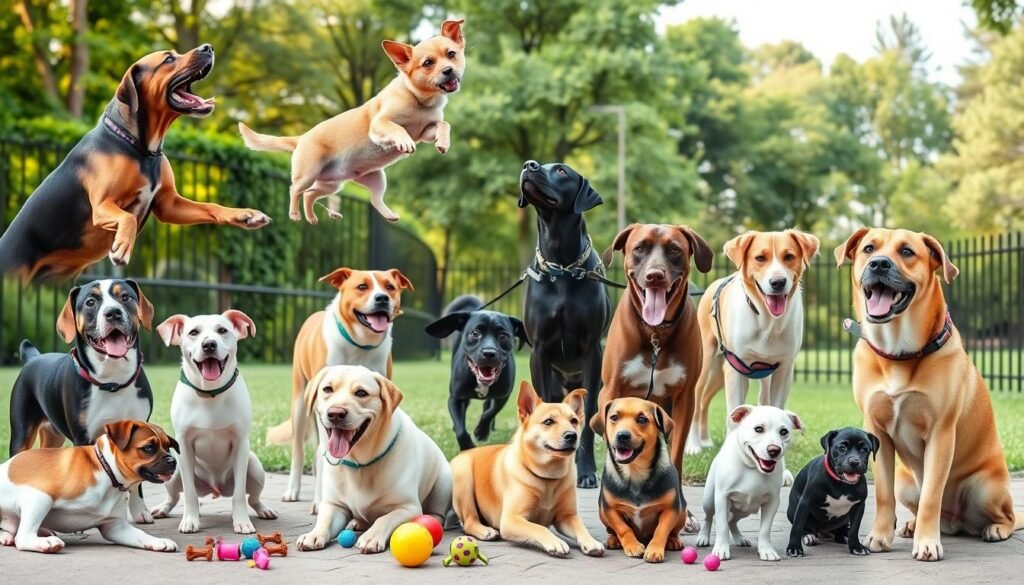
| Behavioral Issue | Potential Causes | Recommended Strategies |
|---|---|---|
| Excessive Barking | Boredom, anxiety, attention-seeking, territorial behavior, fear, response to stimuli | Teach the “Quiet” command, provide mental stimulation, address underlying issues |
| Destructive Chewing | Lack of appropriate chew toys, boredom, teething in puppies | Provide suitable chew toys, increase exercise and mental stimulation |
| Jumping on People | Excitement, attention-seeking behavior | Teach an alternative greeting behavior like sitting, reinforce calm greetings |
| Aggression | Fear, lack of socialization, territorial issues, pain, illness, protective instincts | Seek professional help, use counterconditioning and desensitization techniques |
| House Training Issues | Lack of proper training, marking territory, anxiety, medical problems | Establish a consistent routine, use positive reinforcement, rule out medical causes |
“Addressing common dog behavior issues requires patience, understanding, and a commitment to consistent training.”
Socialization and Environmental Training
Teaching your dog to be well-socialized and trained is key. When they’re young, from 3-16 weeks, they need to meet many people and animals18. This time is critical for their confidence and learning to handle the world18.
Even older dogs can learn new things. Slowly introducing them to new sights and sounds helps them feel more at ease.
Training your dog to get used to different places and textures is also vital18. Taking them on walks in various settings helps them adjust well18. They should get used to loud noises and crowded areas too18.
Good socialization and training make dogs more obedient and calm19. It helps them learn in many places. By making new experiences positive, your dog will grow confident and skilled.
“Socialization is not about teaching obedience but about creating positive experiences around new stimuli.” – Dog Training Elite19
Putting effort into your dog’s socialization and training is worth it. They’ll become a well-adjusted, obedient friend. Start early and be patient. Your dog’s growth is a journey, not a quick goal.
Conclusion: Building a Lasting Bond Through Training
Obedience training is a journey that makes the bond between dog and owner stronger20. By sticking to training rules and practicing often, you can keep your dog’s skills sharp21. It’s also important to keep your dog’s mind active with new activities and learning21.
Every moment with your dog is a chance to teach them something new21. A well-trained dog is happy and confident, making your life together more joyful20.
As a dog owner, I’ve seen how positive training and spending time together can strengthen your bond22. Activities like walks, play, and grooming make your connection deeper20. Reaching 100% obedience lets you explore the world together safely.
The path of ongoing training is a lifelong promise, but the benefits are worth it21. By investing in your dog’s growth, you create a partnership based on respect and love20. Regular vet visits, grooming, and a healthy diet keep your dog safe and happy, strengthening your bond.
FAQ
What is the importance of dog obedience training?
Dog obedience training is key for control, better behavior, and safety. It teaches basic commands like sit, stay, and come. Using positive methods, it prevents bad behavior and strengthens the bond between dog and owner.
How can understanding canine behavior help with effective training?
Knowing how dogs behave is vital for training. Dogs follow a pack mentality, needing clear leadership. Reading their body language helps in training. Different breeds have unique traits that affect training needs.
Understanding these traits helps tailor training. This leads to better obedience training results.
What are the essential steps to start dog obedience training?
Starting dog obedience training begins with basic commands. Start with simple commands like sit, stay, and come. Use treats and praise as rewards.
Consistency in commands and rewards is important. Short, frequent training sessions work better than long, rare ones. Practice in different places to make behaviors more general.
Getting help from certified trainers can be helpful for specific issues or advanced training.
What are some essential training tools and equipment?
Using the right tools makes training more effective. Choose the right collars and leashes for your dog’s size and temperament. Pick high-value treats for motivation.
Consider using clickers for precise timing in training. Tools like treat pouches and crates can also be useful. The right equipment helps in consistent training and reinforces good behaviors.
What are the basic obedience commands every dog should learn?
Every dog should learn basic commands. The “Sit” command is often the first taught, useful for calming dogs. “Stay” helps with self-control and safety.
“Come” is essential for recall and can be life-saving. Use clear, consistent verbal cues and hand signals. Reward immediately for correct responses. Practice in different environments with distractions to ensure reliability.
What are some advanced training techniques and methods?
Advanced techniques build on basic obedience. Clicker training provides precise timing for marking desired behaviors. Marker words can be used like clickers.
Timing rewards correctly is key for effective training. Gradually increase training difficulty to challenge and progress your dog’s skills. Positive reinforcement keeps training enjoyable and strengthens the bond between dog and owner.
How do I teach my dog proper leash walking etiquette?
Teaching leash walking is essential for enjoyable walks. Teach the “Heel” command for walking calmly beside you. Use positive reinforcement for loose leash walking.
Practice in various environments to generalize the behavior. Address pulling by stopping when the leash tightens. Only move forward when it’s loose. Consistent training leads to better walking manners.
How can I address common behavioral challenges with my dog?
Common issues include jumping, excessive barking, aggression, and house training. Teach alternative greetings like sitting for jumping. Manage barking through desensitization and the “Quiet” command.
Aggression needs professional assessment and tailored training. For house training, establish a consistent routine and use positive reinforcement. Early intervention and consistent training prevent these issues.
Why is socialization important for dogs?
Socialization is key for well-rounded dogs. Expose puppies to various people, animals, and environments during their critical socialization period (3-16 weeks). For adult dogs, gradual exposure and positive associations build confidence.
Environmental training includes familiarizing dogs with different surfaces, sounds, and situations. Well-socialized dogs are more obedient and easier to train in various settings.
How can I maintain and improve my dog’s obedience skills over time?
Obedience training is an ongoing process. It strengthens the bond between dogs and their owners. Consistent application of training principles and regular practice maintain and improve obedience skills.
Engage in continued learning and activities to keep your dog mentally stimulated. Remember, every interaction is a training opportunity. A well-trained dog is a happy, confident companion, leading to a more fulfilling relationship for both dog and owner.
Source Links
- Training Your Pup: Mastering the Top 10 Essential Dog Commands | Off Leash K9 Training of Hampton Roads
- Dog Training Science: Understanding Canine Learning & Behavior
- Importance of Canine Obedience Training – For Paws Training
- Do-It-Yourself Dog Training Program
- Dog Training 101: An Ultimate Guide to Fixing Common Behavior Issues
- The Essential Guide to Dog Training Equipment
- Must-Have Dog Training Supplies
- From Sit To Stay: Teaching Your Dog The Most Important Commands | Off Leash K9 Training Of NoVA
- Mastering Dog Training: Basic Commands
- 10 Best Tips on How to Teach a Dog to Sit and Stay Commands
- Positive reinforcement training
- Mastering Advanced Dog Training Techniques
- No title found
- How to Improve Your Dog’s Leash Manners – Whole Dog Journal
- Loose Leash Walking – 3 Lost Dogs Academy (Daybreak Dogs LLC)
- Problem-Solving in Dog Training: Addressing Common Behavioral Issues
- Addressing Common Behavior Problems In Dogs | BetterVet
- Socialise your puppy – train your dog to acclimatise to different environments – Bozita International
- Houston Dog Socialization Classes. DTE
- Building a Lasting Bond: Strengthening Your Relationship with Your Dog in 2024
- Building a Lasting Bond: Essential Dog Training Tips for Deeper Connection
- Building A Lasting Bond
editor's pick
latest video
news via inbox
Nulla turp dis cursus. Integer liberos euismod pretium faucibua

